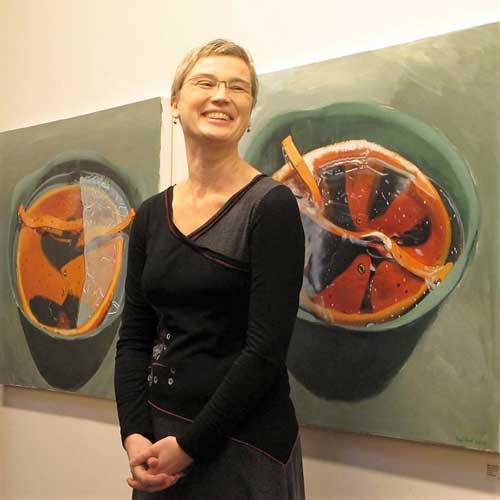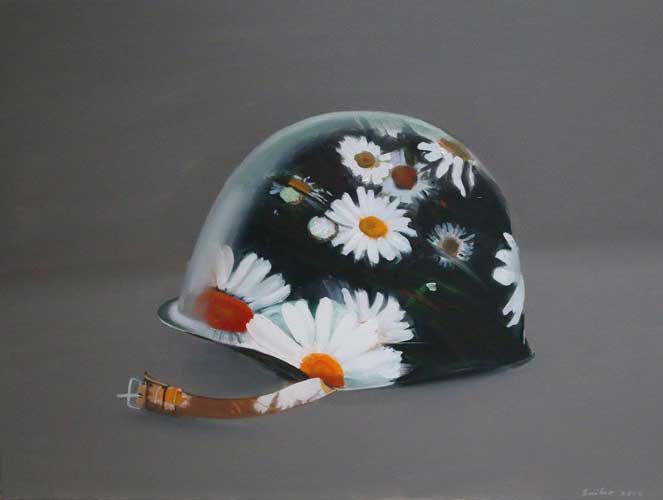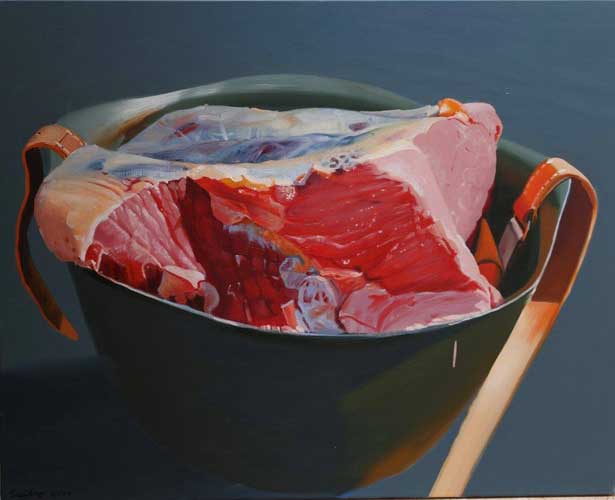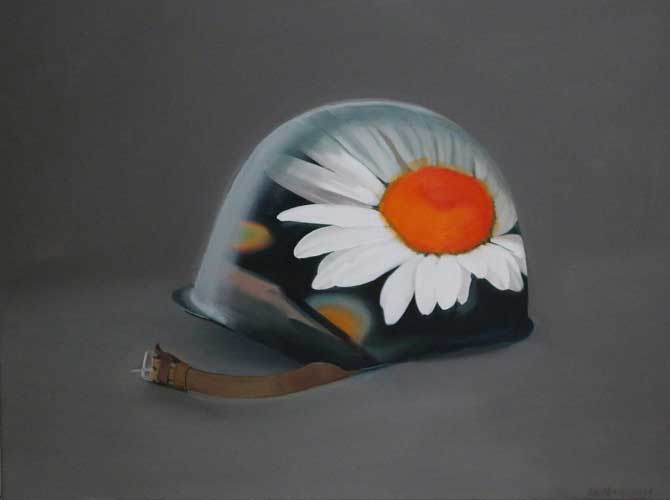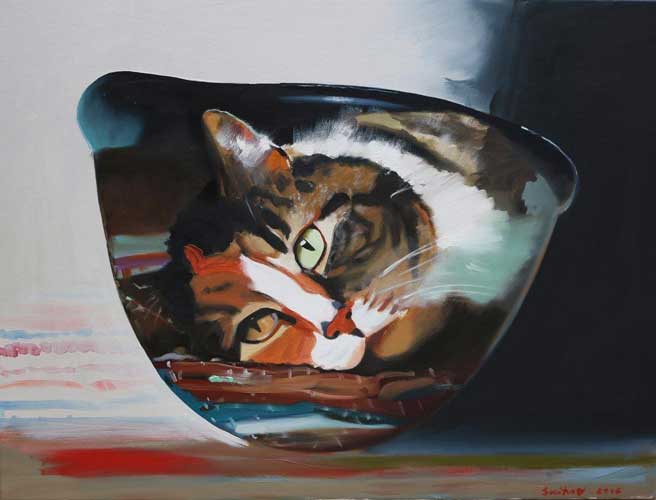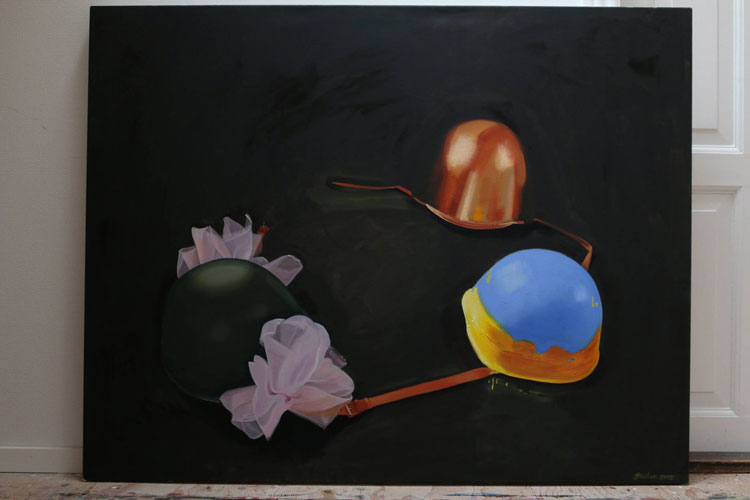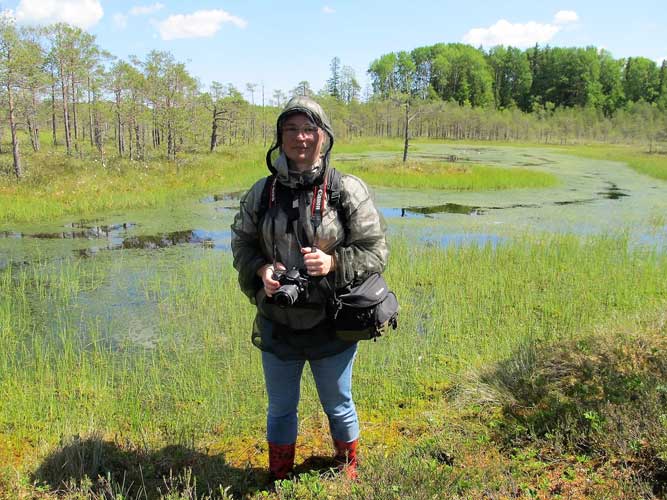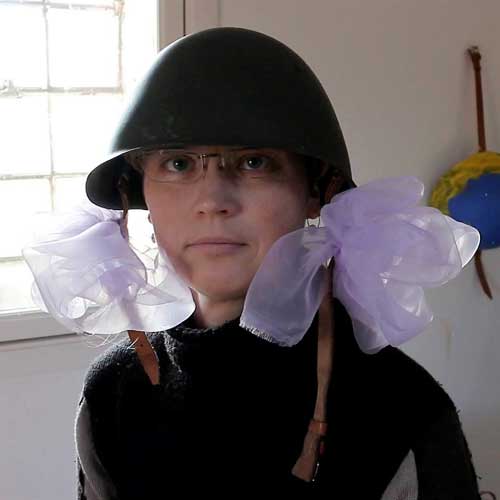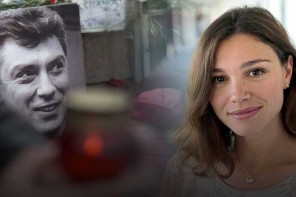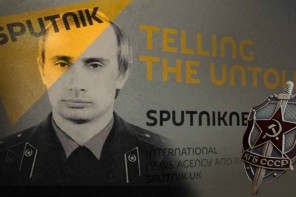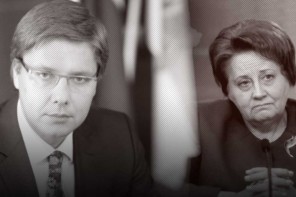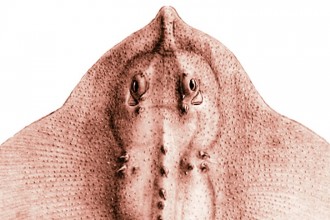Excerpts from the catalogue of Külli Suitso’s series “Helmets”
On Display at Tartu Kunstimaja 27.07.2017-19.08.2017
 Imbi Paju, writer and filmmaker Author of “Memories Denied”, memory researcher/Estonia
Imbi Paju, writer and filmmaker Author of “Memories Denied”, memory researcher/Estonia
When I saw Külli Suitso’s series of paintings ”Helmets” for the first time, it awoke childhood memories in me. My subconscious took me deep into mind landscapes, which emerged as a hologram in front of me: childhood summer mornings at my grandmothers place in the countryside. The house is surrounded by the forest. There are two big and robust hazelnut trees by the well, which provide a gorgeous hazelnut harvest in the autumn. The forest keeps spring and summer warmth around the house. Apple and plum trees, spruces, birches, pines and many flowers – dahlias, carnations, lilies. The yard is heavy with the scent of trees and flowers.
At the corner of the house, between the flowers, there is a war helmet found in the forest, into which grandmother has planted nasturium. Their red, orange and yellow blossoms with alternating colour nuances reach in the direction of both the sun and the earth, and make the helmet, with a bullet hole in it, into a royal crown for a child. Unfortunately, I know that someone has been killed in the war beneath the helmet.
Once, when I was with my grandmother, I found a skull in the forest, even though it was over twenty years since the war. According to grandma, in that particular Estonian forest, there was a battle between the Russians and the Germans during World War II. The Soviet occupation alternated with the German occupation and then the Soviet occupation and a new terror began
again. People’s homes were taken from them, they were labeled as ”enemies of the Soviet people” and were deported to Siberia. The same happened to my mother´s mother´s family.
Many homes were demolished, apple orchards were razed to the ground with tanks and tractors by the occupying forces. Some people managed to escape across the sea to other countries. When I was little, the survivors had already returned to Estonia from Siberia, had planted new appletree gardens and begun to move on with their lives. At that time, I did not really understand that my mother and father had been close to death as children, and later on my mother had been in a Soviet forced labour camp. When I walked around with my grandmother, she always told me that there was divinity in the beauty of nature. And she showed it to me at any moment. I felt it when I smelled pine resin flowing, I breathed the smells of nature and listened to the sounds of nature.
Between 2014 and 2017, I worked on the “Helmet” series. One of the first works was the oil painting. A Helmet with Blue and Yellow, which was completed in March 2014, shortly after Russia annexed Crimea. – KÜLLI SUITSO
There was yet another war helmet in the yard, lying on the grass next to the woodpile. Every morning, grandma poured milk and porridge for the dog into it. It gave life to the helmet and made the dog happy. When it was raining, the helmet was filled with rain water. Sometimes, my grandmother and I picked fallen apples from under apple trees, put them into the helmet and took them to the farm animals. When we went to collect mushrooms, we cleaned the mushrooms of leaves and needles and gathered them into one of those war helmets.
My grandmother told me that during the war she felt sorry for all people. Helmets of young men who perished in the war, lay on their side. No matter what nationality these young men had been, they were, after all, someones children, whose mothers waited for them to come home. There were soldiers who had gone crazy in the war, killed women and threatened to rape them. My
grandmother said: “War makes people crazy, it changes them”. Looking at Külli Suitso’s work, I think that this must be our Estonian grandmothers’ and mothers’ common wisdom – simple, beautiful, life- enhancing and life-retaining deeds that turn symbols of death into symbols of life. And life goes on, begins to bear fruit.
“HELMET” VIDEO
 By Inge Schjødt/art critic from Denmark
By Inge Schjødt/art critic from Denmark
Destiny
It is said that childhood lasts for three generations. Our grandparents’ fears and joys, losses and talents live on within us and have been passed on to us through our parents’ lives. Some things are passed on from within and much comes from our surroundings and blends into life’s symphony.
Through art, Külli Suitso turns the volume of dark echoes and the sounds of life up and down. She adds colours to pictures that appear out of memories, inspiration, years of study and her artistic life. These all make up her life.
The generations preceding Külli Suitso have presented her with a contrasting palette. In the distance is her grandparents’ life in great, beautiful forests, zither music and songs, and her father’s golden hands, which provided for the family. She learns to draw early, already at the age of 10. She is fascinated by nature and later by culture. Light, freedom and independence can be seen shimmering in the eyes of her generation after a long Siberian winter. What vitality, courage and enterprise to leave and find yourself a new homeland!
Here come the helmets, Soviet girl
Childhood memories of military parades and Russian girls’ golden braided hairstyles from that era make Külli Suitso’s blood boil in the spring of 2014, when the sky darkens due to the Russian army’s clamour of war in the east. Helmets appear on her retina. You cannot escape from threats, fear, anger and worry. You have to react to them with oil on canvas, through printmaking, in videos and installations. Külli Suitso develops the helmet series over the course of the next two to three years. Helmets full of human life, apples and ice water
A helmet is an extremely practical component of a uniform. It is full of strength, masculine virtue, pride and spaciousness. But what is left of the individual? Uniforms neutralize, limit and hide the individual. Is there any room for the taste of oranges, for the poetry of flowers or ladybugs? Oranges, flowers and ladybugs are vital to prevent our hearts from freezing to ice. The artist gives us the contrasts, and lets us then admire them.
Bread and life
In the hands of an artist, helmets can hold a lot. By filling them with fruit, candy and food, their severity is broken. The anxiety becomes edible and it is possible to adapt it into everyday life.
In the video, where dough is kneaded and bread is baked over the fire, the helmet is completely
conquered. The helmet has returned home and has been converted to an object of everyday life. Everyday necessities snatch the power from the war symbol, and this changes the essence of the helmet for good. It´s an impressive story – almost ritualistic in nature.
Finally, the helmet and the skull get a pacifier stuck in their teeth and are asked to be quiet! The pilot dons a modern uniform and takes off! Away from the rotten apples.
The art speaks
A body remembers many impressions through its existence. An artist also has to fight everyday struggles, struggles with colour, surface, structures, motifs and the struggle to remain a living person in the society you are at all times a part of. Külli Suitso has received a solid base thorough education at the Children’s Art School in Tartu and the painting department at the University of Tartu. Encounters with wonderful teachers such as Boris Lukats, Paul Saar, Ene Liik, role models in the art world, have given her insight and inspiration.
For me, the series of helmets is about much more than the Russian-Ukrainian conflict, tells Külli Suitso. It is not reporter art. My motifs balance with humour on the edge of kitsch and highlight the many contrasts we meet.
“For me, the helmet series is more than just the Russia-Ukraine conflict,” Külli Suitso says. “It is not the art of reporting. My motifs are full of humour, they are borderline kitsch and highlight a lot of contrasts that we encounter in life. Art does not come from an ivory tower, it comes from the time in which we live, where something touches and influences you, and where you can also assert influence.”
Our own lives lead generations to follow. The mystery of our lives is to understand and want, to remember and choose what we want to recount and to choose what we wish to create – whether death or the joy of colour, light, life and peace.
“Everyone is the frontline soldier of their own life,” Külli Suitso says, smiling.
Yes, everybody has to find their own place on the battlefront and move ahead in history. Go ahead in the name of achieving their dreams, wishes, and needs. Let’s step in the chain, to pass on the baton in both life and art.
KÜLLI SUITSO
“Between 2014 and 2017, I worked on the “Helmet” series. One of the first works was the oil painting. A Helmet with Blue and Yellow, which was completed in March 2014, shortly after Russia annexed Crimea.”
“The helmet is a strong symbol. It is usually associated with war, destruction, suffering, death… but also protection. Concrete and recognizable symbols of a soldier’s belonging and as well as hierarchy are attached to military helmets of different forces. But underneath the helmets and uniforms, inside the human soul of the person, sent to fight for or against something, there are totally personal thoughts, feelings, wishes, dreams, longings… and fate.
In this helmet series of works, I play with strong, absurd contrasts. I paint strawberries, daisies and white clouds on the helmets. I fill helmets with apples, still water, ice, snow, dough, meat, sweets and flowers, to balance the dark sides of a human being.”
Education: Tartu University Painting Department
Medium: painting, printmaking, short films.
Külli’s works have been exhibited in Estonia, Latvia, Finland, Sweden, Austria, the Komi Republic, Slovenia, Mexico and Denmark.
The Helmet series includes 37 oil paintings, 1 drypoint, 1 video and 1 installation.
The exhibit catalogue is edited by Imbi Paju. People from different countries and different walks of life have written about their thoughts and experiences about war and peace, about preserving life and humanity.
Imbi Paju – writer and filmmaker EST
Inge Schjødt – art critic DK
Toomas Hendrik Ilves – President of the Republic of Estonia EST
Elisabeth Rehn – former Finnish Defense Minister FIN
Enel Melberg – writer SE
Christian Højlund – theologian and psychotherapist DK
Harry Liivrand – art critic EST
Mary Jordan – artist and human rights activist in the United States

